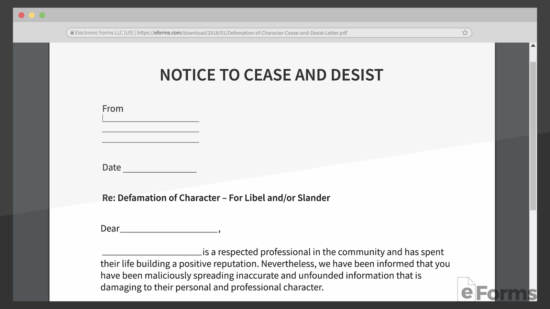Updated September 18, 2023
A defamation cease and desist letter is sent to record and report false or erroneous claims that result in the defamation of character in an individual or business entity. The letter should outline the specific statements that were made and how they are affecting the reputation of the person or business. Furthermore, a full retraction of the statements should be requested. If there is no response by the other party or a retraction of the statements is rejected, the harmed party should seek full damages for the falsehoods made.
Federal Definition
The term “defamation” means any action or other proceeding for defamation, libel, slander, or similar claim alleging that forms of speech are false, have caused damage to reputation or emotional distress, have presented any person in a false light, or have resulted in criticism, dishonor, or condemnation of any person.[1]
Table of Contents |
Types of Defamation
There are two types of defamation:
- Per Quod – Plaintiff can prove actual damages. For example, if a speaker has a stadium sold out and, after false statements are made, the ticket-holders begin to demand refunds. The plaintiff would be able to show actual damages to the comments that were made.
- Per Se – The damages are so widespread that the plaintiff cannot prove actual damages. This is the most common and is broken down further into four subcategories:
- Criminal conduct – Claiming someone was convicted of a crime or labeling them as a criminal.
- Business or Profession – Harming the reputation of a business.
- Lonesome Disease – For example, claiming an individual has an STD.
- Imputation of Unchastity – Unjust sexual behavior such as claiming adultery.
Libel vs. Slander
Libel is false statements made in writing such as newspapers, magazine, tabloid, website, or any other open platform.
VS.
Slander is false statements made verbally on radio, television, online, or any public venue.
How to File a Defamation Lawsuit
Filing a defamation lawsuit requires the harmed party to prove any statements, accusations, or publications that have been made were false or severely inaccurate to the point where damages were incurred. Whether the damages need to proven will be up to the court.
Step 1 – Gather the False Statements

Collect any and all evidence of the false statements made. If by radio, podcast, television, or other online formats, be sure to record the publications by screenshots and submitting to archive.org to make a verified third (3rd) party citation. It’s important to gather as much evidence as possible before any notice has been sent to the defendant in case it’s taken down at a later time.
Step 2 – Show the Statement is Inaccurate

The plaintiff will need to represent that the claim is false. This should be a simple task as, for example, if the defendant makes the claim that the plaintiff is a drug dealer, public records will show that the plaintiff has never been convicted of any related crime.
Step 3 – Write the Cease and Desist Letter

Depending on the plaintiff’s claims, the defendant will be required to stop making specified statements as well as may be asked to retract the claims that were made. At the sole decision of the plaintiff, if they feel a public retraction of the statements made is enough, then that will be the end of the matter.
Although, the letter may serve as a prelude to a lawsuit with only requesting the defendant cease making further statements until a court hearing date.
Step 4 – Claiming Damages

Before a civil complaint is filed, which is a document filed to begin a lawsuit, damages to the plaintiff should be estimated. In most cases, a monetary value cannot be directly attributed to the statements that were made. Therefore, it’s important to look up other related cases and judgments to see what other related parties were awarded for such defamation claims.
Example #1 – Melania Trump vs. DailyMail
In 2016 there was a story published by the DailyMail that inaccurately made the claim Melania Trump was an escort in the early 1990s. These claims were refuted and she filed a defamation lawsuit totaling $150 million in damages. The DailyMail submitted a retraction and apologized while agreeing to pay $3 million.[2]
Example #2 – Andy Crews, Dick Anagnost, and William Greiner vs. Michael Gill
In 2017, a New Hampshire billboard owner began running false statements next to a busy highway defaming three (3) prominent businessmen and their companies in Manchester, New Hampshire. The statements on the billboard included “drug dealer” and “extortion”, along with similar references. Due to the large presence the billboard had in the market area, in court awarded the three (3) men a $274 million judgment.[3]
Step 5 – Prepare and File the Lawsuit

Once the case is prepared, mainly gathering evidence of defamation and calculating the damages caused, the plaintiff is ready to file their defamation lawsuit complaint in the court of proper jurisdiction. The attorney will most likely take it from here and there may be a notice period, depending on the State, when the defendant must be notified before officially filing in the district court.
Defamation State Laws and Definitions
- AL – § 13A-11-163
- AK – AS 21.36.070
- AZ – ARS 20-445
- AR – 660 S.W.2d 933
- CA – CIV 46
- CO – 882 P.2d 1293
- CT – DeVito v. Schwartz et al.
- DE – 261 A.2d 529
- FL – § 836.04, 997 So.2d 1098
- GA – § 51-5-1, 573 S.E.2d 376
- HI – 962 P.2d 353
- ID – § 18-4801, 943 F. Supp. 2d 1125
- IL – 34 N.E.3d 549
- IN – 750 N.E.2d 433
- IA – 380 F. Supp. 2d 1002, 512 N.W.2d 777
- KS – § 21-6103, § 40-2404(3)
- KY – § 432.280, 151 S.W.3d 781
- LA – RS 14:47
- ME – 672 A.2d 82
- MD – 935 A.2d 719
- MA – MGL c.272 § 98C & c.176D § 3(3)
- MI – MCL § 600.2911 & 750.370
- MN – MS 609.765, 766 N.W.2d 910
- MS – § 97-3-55 & 97-3-57, § 95 Ch. 1
- MO – MO Rev Stat § 537.110 & 509.210
- MT – § 45-8-212, § 27-1-802 & 27-1-803
- NE – RS Ch. 25 § 208, 839, 840 & 840.01
- NV – NRS 200.510(1), 57 P.3d 82
- NH – RSA 644:1 & 507-A, 106 N.H. 26
- NJ – 116 N.J. 739
- NM – § 30-11-1 & 41-7-1 – 41-7-6
- NY – CVR § 74 – 78, 75 N.E.2d 257
- NC – GS § 99-1 – 99-5, 442 S.E.2d 572
- ND – § 12.1-15-01 & § 14-02-01 – 14-02-11
- OH – § 2739.01 – 2739.99, Murray v. Knight-Ridder, Inc.
- OK – § 21-771 – 21-781, § 12-1441 & 12-1442
- OR – § 31.200 – 31.230, 244 Or. 267
- PA – § 8343, 544 Pa. 117
- RI – 555 A.2d 321
- SC – SC Code § 16-7-150, 271 S.C. 276
- SD – SDCL § 20-11-3 & 20-11-4
- TN – 172 S.W.2d 13, 83 S.W.3d 125
- TX – § 59.002, § 119.201, § 122.251
- UT – § 76-9-404, § 45-2-2
- VT – Cooper v. Myer
- VA – § 18.2-417, § 8.01-247.1
- WA – 225 P.3d 339
- WV – WVC § 57-2-4 & 21-3E-13
- WI – § 942.01, Defamation Law of Wisconsin
- WY – WS § 1-29-101 – 1-29-106


